
|   |

|   |
 e-mail: leelakaverivenkat@gmail.com Yoga / Nritya reaches out to the common public Photos courtesy: IGNCA Delhi July 16, 2019 Yoga as a means of attaining a state of complete harmony where body, mind and soul are united, forms one of ancient India's traditional disciplines. This state-of- being, when experienced, is described as one of pure joy or ananda. And all art forms also are regarded in the traditional world view of the country as sadhanas (disciplines which form the means), as a yoga and sacrifice with the same aim of evoking bliss or ananda. This state of complete harmony or samarasya is one of total release (svatantrya) from the life bonds, attaining visranti. The world view of the Hindu is of a seeker aspiring for that state of self realization and indivisible oneness or harmony leading to joy. Yoga has also been defined by scholar Dr. Kapila Vatsyayan (in her book Indian Classical Dance in Literature and the Arts) as that complete efficiency or what Bhagavat Gita calls the karmasukausalam, whereby every bit of mental energy gets concentrated in achieving that one end in view, while enabling the person concerned to see the underlying unity in everything. The inner freedom that Yoga aspires for is through a discipline which is ethical, non-violent, non-exploitative, and health promoting. The Indian mind regards the body as the centre of all existence for without it there is no way of experiencing this Universe. And this body comprising the physical, the mental and the spiritual needs all these aspects to be in synch. Thus Yoga Sastra in its Asanas or postural attitudes, seeks that perfect alignment which creates inner tranquility. This unique approach of dividing the human form into immaculate laws of measurements of tala and angula and the relationship of each to the different axes or sutra - comprising an anatomical exactitude can be seen in sculpture - while in music notes are used in a scale of measurement where arithmetical validity acquires an emotional and spiritual significance. In fact, all dance sharing the same goal of self realization is a Yoga. But while Yoga is non-performist in the sense of sharing an audience, dance has a strong performance manifestation, which involves the evoking of rasa. Patanjali, the founder of Yoga, who in his step by step gradation of activating the various energy centres, till the sadhak attains the final samadhi and Kundalini Shakti, treats the body site as the temple where prayers are offered through the Asanas - as the late BKS Iyengar, an authority on Yoga, stoutly maintained. In the case of dance also the body is the temple, with dance being the prayers offered. Arts aimed at an audience, have to evoke rasa and for this the artist has to be in a state of preparedness and the Yoga discipline makes an excellent preparatory tool for the dance aspirant. 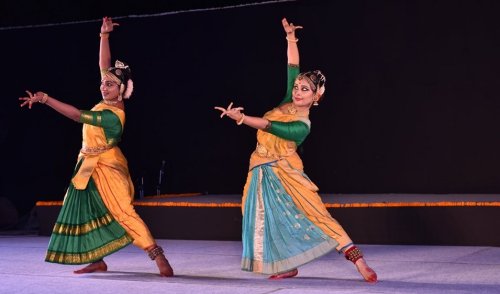 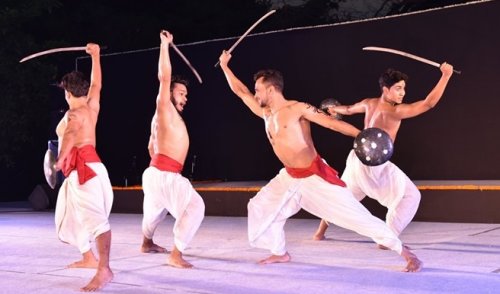 The special evening organized on June 21, 2019 at IGNCA's Matighar lawns, titled 'Yoga Nrityam' was the culmination of a two month workshop led by experts to disseminate Indian classical art forms, highlighting the Dance/Yoga shared spirit, among the common public. What started off as an experiment, in the kind of response it evoked from the general non dance knowing public, was a pleasant surprise. Sharing the spirit underlining the workshop, which was more a process to inform, and create rasikas rather than dancers, the stage for the evening was shared by the initiated with the non initiated but interested public of all age groups attending the workshops. Kathak dancer Shovana Narayan as chief guest, in her inaugural speech very lucidly brought out the Yoga/Dance relationship. Briefly mentioning how art techniques have the same spiritual aim taking off from the same philosophy (the founding principle ensuring continuity and mutual give and take among traditional arts), Shovana Narayan brought out the close links between Asanas and dance postures using some examples like Vajrasana, Garudasana, Tadasana, Katichandra Asana, Ardhachandra etc. Explaining how Asanas are static postures, while movement in dance covers stage space, she said that while moving from one movement to another in dance, the principles of Yoga Pranayam come into play. In fact, the technique of right breathing stressed in Yogasanas, comes into play in vocal music rendition. The performance part of the evening projected young, talented Anjaneya Joshi playing the flute with fine melodic control, his breath control playing a large part apart from his swargyana, particularly in holding the 'sa' note in the higher octave - which most of the rest of the group could not - in complete sruti control. 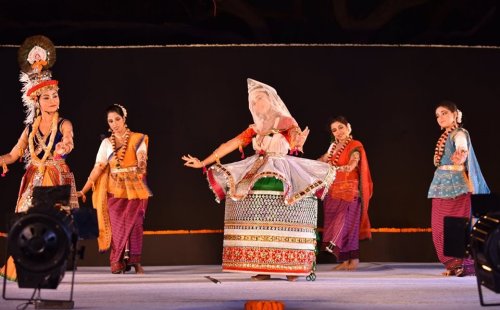 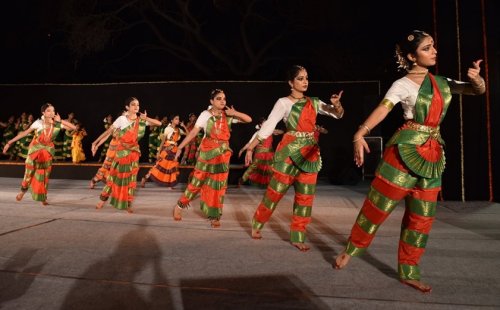 After the convincing talk by Shovana Narayan, the performance part curated by Bharatanatyam dancer Swagata Sen Pillai had each sequence beginning with a combination of trained dancers and uninitiated rasikas, concluding with an edited item from the classical repertoire of the concerned art form. If body discipline (close to the Yoga asanas) of Chhau by students of Rakesh Sai Babu underlined stillness in the body - external and internal in the neatly executed typical martial art of the Paikas of Odisha, meditative quiet resembling Yoga's anandamayakosha was expressed in Raas of Manipuri by students of Guru Singhajit Singh. Jaya Rama Rao and Vanashree Rao's students presented Shiva Tarangam with the entire group of trained and untrained persons of all ages combining. The Vinayaka Stuti Sri Vighnarajam Bhaje set to khanda chapu talam dedicated to the Lord in the temple in the village of Kuchipudi, has a history, its underlying aim being meditative, like Yoga. Early morning, all young boys of the village gather and do special Yoga like exercises for over half an hour and then present Ganesha Kavutvam and Chakrasanam, and Yoga's Surya Namaskaram - this entire part in Telugu is termed Beski and Dandamula and this is followed by Sri Vighnarajam Bhaje with the movements in Khandajati. The condensed group presentation was followed by just the dancers Ayona and T. Reddi Lakshmi presenting "Shiva Shiva Bhava Bhava Sharanam" tarangam in Surutti, with rhythm executed with feet balanced on a brass plate. 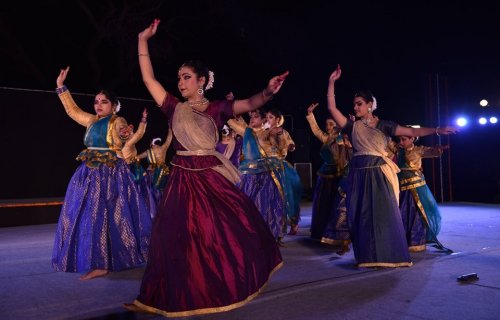 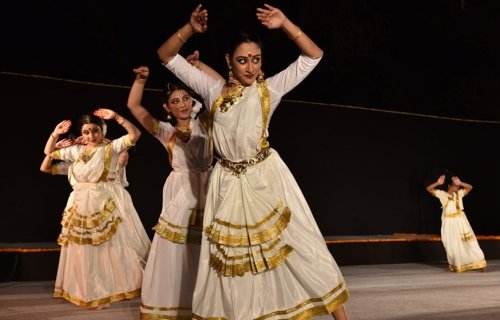 Malti Shyam's group of Kathak aspirants after chanting and moving to the Guru Brahma salutation had the dancer students presenting the Tarana in Malkauns, the music composition by Madhup Mudgal. The Mohiniattam group under Bharati Shivaji, after a Solluketu set to raga Nattai, presented a delightfully gifted young dancer Anaghashri in a composition set to Padi followed by Neelambari "Ambatti onnu saptaswara Panchavarnattodu taalattodu." What one found fascinating was the beautifully outlined andolika grace in body movements and her netra glances, pointing to a dancer to watch out for in the future. The Odissi segment under Madhumita Raut's direction presented Batu Nritya- which with its repetitive music based on rhythmic syllables "Take Dha Dha Kitataka Ta Ham Tari.." abounds in sculpted stances, in a likeness to Yoga. The dance included Odissi Bhangis like Darpana and Venu. Accompanied by typical music, dance movements for the Sattriya component, abounding in imagery from Nature - water, leaping deer, birds etc. was led by Prateesha Suresh. 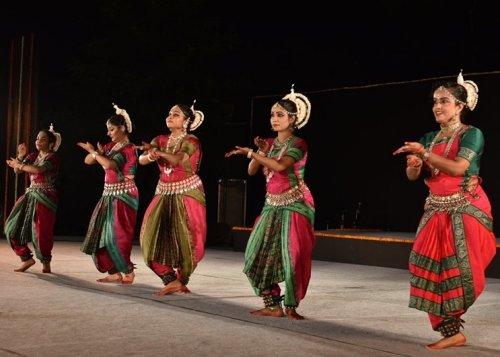 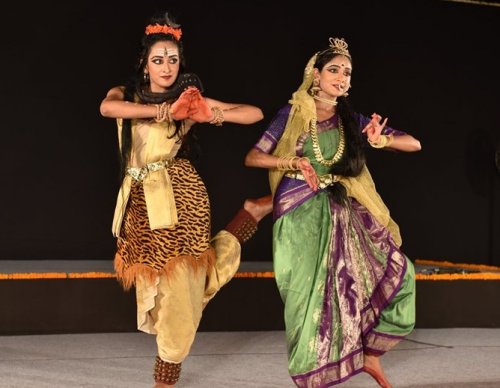 Swagata Sen Pillai designed Bharatanatyam segment was the concluding dance sequence, the theme being Shiva /Shakti, "Sarvam Brahma mayam." The contrasting nature of Ardhanareeswara with Parvati's Dhamilla and Shiva as Jatadhara in Shankaracharya's hymn "Champeya gauraardha shareerakayai, Karpoora gauraardha shareerakaya" with the concluding Namah Shivayai cha Namah Shivaya salutation ended the presentation in strains of Hindolam. While this was not really a program for showcasing excellence, the evening managed in a way where the mixed nature of the participants did not stick out like a sore thumb, while bringing out the Yoga/Dance relationship. And because of the wide nature of participation, the audience size in the open Matighar Lawns was encouraging. Considering the nature of the evening, each segment should have been crisper, so that the last half hour did not drag.  Writing on the dance scene for the last forty years, Leela Venkataraman's incisive comments on performances of all dance forms, participation in dance discussions both in India and abroad, and as a regular contributor to Hindu Friday Review, journals like Sruti and Nartanam, makes her voice respected for its balanced critiquing. She is the author of several books like Indian Classical dance: Tradition in Transition, Classical Dance in India and Indian Classical dance: The Renaissance and Beyond. Post your comments Please provide your name and email id when you use the Anonymous profile in the blog to post a comment. All appropriate comments posted with name & email id in the blog will also be featured in the site. |